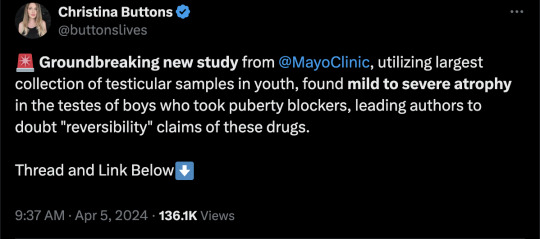#atrophied
Text
Putting this fic in a pillowcase and beating it to death
#i thought this was gonna be easy#nice warm up#i will never write again#the muscle has decayed#atrophied
6 notes
·
View notes
Text

#lmao#for anyone who's curious the process went:#send ask to aita official#blog blows up#someone realizes its a chexer fic#i follow them bc they seem cool#i join their rvb server#their encouragement pushes me to finish the Actual Fic i was working on#i expand the fic to be more of a whole au after it comes out much better than expected#the next fic in the au that i work on has to do with a character's brain injury#this leads me to do research into brain injuries#''......huh. this sounds. a lot like the neurological symptoms that my doctors have been saying is just part of my anxiety disorder''#think on that for a while#go to the ER for unrelated reasons#remember my theory#bring it up to the doctor#Doctor Immediate Concern#doctors orders a ct scan#''eeyup! that there's some atrophying and a chiari malformation! y'ever had a head injury''#(i had had several)#''well! shit! time to refer you to neurosurgery :) see if we cant do somethin about all that memory loss and severe pain and shit''#and now we are here#it also lead me to research osddid systems for the first fic#and now my therapist is having me tested for osdd because i did not know that those symptoms were not a thing everyone experiences#so like. thanks for helping me meet friends who could encourage me to engage with the things i like + learn more about myself#^ ^ <3#im actually not gonna say ''ok last update fr this time'' bc idfk maybe something WOULD be funny to post on here
6K notes
·
View notes
Text
Love a self-inflicted time loop. The main character isn’t trapped. They can stop whenever they want. But how can they when things aren’t perfect yet? They can do better than this. They need to try again. They can get it right this time. They just need to try again. They can stop anytime they want. Just one more time. They can fix this. They just need to try again. There are still things to fix. They just need to try again.
#time travel#its about the tunnel vision#its about losing sight of what a win condition even looks like#its about writing off the entire timeline at the slightest inconvenience#its about increasing alienation#its about failing to notice that youre destroying yourself and in some cases making things worse#its about the atrophy of your own problem solving skills#its about treating your friends like unskippable cutscenes#its about gradually forgetting everything outside the loop#its about the fact that you arent even really trapped#its about making the same choice over and over again#its about falling hard into the sunk cost fallacy
26K notes
·
View notes
Text

The project is going along smoothly- realized I haven’t actually posted in awhile so here’s the nightwatch bad sans ref sheet. If your wondering why dust is becoming a homestuck character it’s burn damage. Bones become grey and black from severe burns blah blah. Anyways they are all ok and it’s a really wholesome au 🫶😁 hahaha yes…yes…
#psychology sans#nightmare sans#atrophy sans#horror sans#killer sans#dust sans#nightwatchau#utmv au#utmv#utmv oc#sans au
2K notes
·
View notes
Text
What is Spiritual Atrophy?
Atrophy is a medical term that describes a decrease in the size, function, or strength of a particular tissue, organ, or body part, typically due to a lack of use or stimulation, disease, or other pathological conditions. The term can be applied to various types of tissues in the body, including muscles, nerves, bones, and organs such as the brain, heart, and liver.
Atrophy is characterised by a…

View On WordPress
1 note
·
View note
Note
I love you lifelong vaginal atrophy
i love you topical estrogen that treats atrophy and doesn’t interfere with testosterone at all. i love you modern medicine that makes safe and harmless transitions possible. i love you health professionals who explained the risks of taking testosterone to me calmly and told me exactly how we would respond to each one if they ever became an issue because they’re not scary or unmanageable if you have good, competent people on your side.
i hate you terf rhetoric that completely ignores the actual reality of testosterone hrt in favor of portraying it as poison. i hate you transphobes who try to make me scared of the medication that gave me my life back.
#these people have no fucking clue what they’re talking about#and anyway. you think atrophy would be the worst of my lifelong health conditions?#these people will be like ‘you’ll be a lifelong medical patient!!!’ okay??? im a fucking cripple i already am#anon hate#examples of transandrophobia#transandrophobia#transandromisia#transmisandry#virilphobia#virilmisia#anti transmasculinity#transmascphobia#trans men#transmascs
7K notes
·
View notes
Text




#pokemon#crochet#amigurumi#hydreigon#pokemon crochet#art#artists on tumblr#dragon#plush#foth#fresh off the hook#that means i just made this one!#poll#this took me several hours over two days#there's so many little bits#also for your convenience and my desire for praise here are some pre selected compliments that you may bestow upon me#anonymously even#did i mention it took me many hours and has lots of fiddly bits#it's so much more detailed than pictured#frayed off looking tail and wispy six segmented wings#flower crown eight petal looking things around the head and both hand heads#flat atrophied looking legs (is there a lore reason for that? will check later)#definitely a contender for coolest fucking individual crochet i've made yet
624 notes
·
View notes
Text
I am FINALLY at the stage where I can walk without my aircast, but it’s painful in a way I didn’t expect? the sole of my foot has become so tender that it hurts to walk on. it’s also texturally different (less thick hard skin) so maybe I’ve just developed soft sensitive baby feet from not walking on it for two months? very interesting
#the muscles in that leg have also visibly atrophied#so I can’t walk in anything but a penguin shuffle
651 notes
·
View notes
Text
“not all men” you’re right. eugene fitzherbert would never do this
#tangled#flynn rider#eugene fitzherbert#tangled the series#rapunzel’s tangled adventure#atrophy says stuff
891 notes
·
View notes
Text



More of the things
#hoof draws#misc. dailies and such#the only thing I've had motivation to draw all week has been 15 min warmups so i don't atrophy completely#so the stoats are the only things there. sorry
198 notes
·
View notes
Text


By: Christina Buttons
Published: Apr 4, 2024

[ Figure 2: Representative images of Hematoxylin and Eosin-stained sections of testicular tissue biopsied from the testis from GD patients (A) with and (B) without PB exposure. ]
In a groundbreaking study from the Mayo Clinic, a globally recognized leader in medical research and patient care, researchers examined the effects of puberty blockers on testicular development in gender dysphoric male children. Their investigation revealed evidence of mild to severe atrophy in the sex glands of these children, leading the authors to express doubt in the claims of “reversibility” often made about puberty blockers.
The authors assert, “We provide unprecedented histological evidence revealing detrimental pediatric testicular sex gland responses to [puberty blockers].”
This preprint study, not yet peer-reviewed, presents evidence that puberty blockers induce significant cellular changes, impacting testicular development and sperm production in ways that are not fully reversible, with potentially permanent effects on testicular function and fertility. It challenges the longstanding view of puberty blockers as a reversible "pause button" on puberty.
As noted by the researchers of this study, no long-term studies exist for the use of puberty blockers in the context of stopping puberty for gender dysphoric children, and many potential health consequences remain unknown. In particular, the long-term impact on reproductive health is uncertain, making this study critical for filling this knowledge gap.
To address these unknowns, the Mayo Clinic has established the largest collection of testicular samples for patients aged 0-17 years, including those with gender dysphoria who have and have not yet received puberty blocker treatment, creating a database of over 130,000 individual cells for analysis.
Using a novel approach, the research team meticulously analyzed testicular tissue samples from youths undergoing puberty blocker treatment, with those not on puberty blocker treatment serving as controls. This comparison provides important insights into the potential cellular and molecular changes induced by these drugs.
Key Findings
The study utilized the Mayo Clinic's Pediatric Testicular Biobank for Fertility Preservation, which has been recruiting patients primarily from pediatric urology departments since 2015. Researchers analyzed testicular specimens from 87 young individuals (ages 0-17) undergoing fertility preservation surgery for various health reasons. Among these, 16 were gender dysphoric boys between the ages of 10 and 16, all of whom began identifying as transgender girls between the ages of 2 and 15. At the time of surgery, 9 patients (56%) were already on puberty blockers, with exposure ranging from 3 to 52 months. The authors noted that 100% of the 16 children would eventually go on to take them, highlighting “the widespread nature of PB intervention in this demographic.”
Among nine patients treated with puberty blockers, two exhibited unusual features in their testicles upon physical examination. One patient had abnormalities in both testicles, including incomplete development of the tunica albuginea, which is a protective covering around the testicles. The other patient had a right testicle that was difficult to detect.
In one part of the tissue-level analysis, over 400 testicular biopsy samples were analyzed and stained to examine the differences between those treated with puberty blockers and those who were not. Comparisons showed that testicular development in those treated with puberty blockers was abnormal compared to non-treated individuals. There was variability in how individuals responded to puberty blockers, leading to different outcomes in testicular development, including the degeneration of testicular tissues.
The study authors presented a case of a 12-year-old patient who underwent treatment with puberty blockers for 14 months. In this individual, 59% of the sex glands showed complete atrophy, along with the presence of microlithiasis—a condition where small clusters of calcium form in the testicles. This insight suggests that puberty blockers could lead to lasting structural changes. Additionally, research has shown a link between testicular microlithiasis and testicular cancer.

[ D) Representative images of normal (top) and fully atrophied sex gland (bottom). ]
This study also utilized single-cell analysis to investigate the effects of puberty blockers and aging on testicular cell composition. It took a very detailed look at individual cells from the testicles of a 14-year-old who had been on puberty blockers for over 4 years. The study analyzed a total of 130,100 cells, including 11,199 cells from the juvenile puberty blocker-treated patient.
The study observed that over 90% of the cells responsible for sperm production in this patient were stunted at an early developmental stage, unable to progress further. Additionally, it found "pathologically" higher and lower levels of two types of support cells (Sertoli cells) necessary for healthy sperm development. These findings suggest that puberty blockers can disrupt the normal maturation process of cells critical for sperm production.
In another part of the analysis, the authors found distinct cell-specific changes, including altered expression patterns of puberty-associated genes in endothelial cells, due to puberty blocker treatment. The authors believe that these drugs might induce juvenile testicular atrophy in part by disrupting the normal function of testicular endothelial cells.
Another aspect of the study focused on examining the effects of puberty blockers on the genetic activity of early-stage sperm cells, revealing significant changes that could potentially influence their development and fertility. By analyzing the activity of specific genes within these cells, the researchers found that puberty blockers may have caused alterations in gene expression, affecting processes crucial for the normal growth and function of these cells. This analysis suggests that the use of puberty blockers in gender dysphoric youth could have lasting implications for their reproductive health, particularly by impacting the ability of these early-stage sperm cells to mature properly.
Study Impact
Puberty blockers are increasingly used as a treatment for gender dysphoric youth to halt the development of secondary sex characteristics, such as breast development and widening of hips in females, or the growth of facial hair and deepening of the voice in males. Thousands of children in the United States are placed on this medical pathway as part of the gender-affirming model of care, under the presumption that these drugs are safe and fully reversible.
However, many aspects of the long-term consequences of puberty blockers, which have been administered to children off-label in an experimental manner, remain unknown. This study contributes valuable insights into the potential irreversible harm these treatments can cause to bodily and reproductive functions.
Arguably, the most critical finding is the evidence of mild to severe sex gland atrophy in children treated with puberty blockers. This atrophy signifies potential damage or impairment to the structures essential for sperm production, raising serious concerns about the long-term fertility impacts of these drugs for these individuals.
Given the Mayo Clinic's esteemed reputation in the medical and research communities, should the study pass peer review without any issues, its findings will carry significant weight.
Broader Implications
Puberty blockers belong to a group of synthetic gonadotropin-releasing hormone (GnRH) analogues. These drugs act on the pituitary gland to hinder the release of chemical signals that typically trigger the production of estrogen and testosterone. Historically GnRH analogues were used to treat conditions such as prostate cancer, fibroids, and endometriosis and, in some cases, as a measure to chemically castrate sex offenders.
In children, puberty blockers prevent the natural changes of puberty driven by sex hormones and have been used to treat central precocious puberty, a condition where a child begins to sexually mature much earlier than usual. In gender dysphoria, puberty blockers are administered experimentally, lacking long-term testing.
Notably, the U.S. Food and Drug Administration (FDA) has not approved puberty blockers and sex hormones for use in pediatric gender care. No clinical trials have substantiated the safety of these drugs for such non-approved applications and manufacturers of puberty blockers have repeatedly declined to conduct safety trials for their use on this cohort.
While puberty-blocking drugs are often promoted as “safe,” "reversible" and a "pause button" on puberty, these characterizations seem to stem from their approved use for treating central precocious puberty in younger children, not their burgeoning off-label use for managing gender dysphoria in adolescents.
Past studies have indicated possible negative effects on bone density and brain health. There is also a concern that these drugs might solidify gender dysphoria in adolescents, potentially leading them down a lifelong road of biomedical interventions. Following reports in 2016 of suicidal ideation in children administered puberty blockers, the FDA instructed drug manufacturers to include a warning about potential psychiatric issues on the drugs' labels.
Puberty blockers are increasingly administered to adolescents at Tanner Stage 2, the first signs of puberty. Research shows administering puberty blockers at this stage, followed by cross-sex hormones, may result in infertility, sterility, and sexual dysfunction. Furthermore, they inhibit the development of mature male genitalia, making it difficult to create a pseudovagina in the event of a later vaginoplasty due to a lack of sufficient tissue.
The National Health Service England recently announced it would no longer prescribe puberty blockers to youth outside of research settings and closed down its only national clinical service for pediatric gender medicine, following a review that deemed the service "not safe.”
Several European countries, including Sweden, Finland, the UK, Denmark, and Norway have updated their guidelines for youth transition to align with systematic evidence reviews, the gold standard in evidence-based medicine. These reviews concluded that the risks associated with youth transition outweigh any purported benefits. Consequently, these countries have implemented restrictions on medical interventions, prioritizing psychotherapy as a first-line response for minors experiencing gender-related distress.
==
They're sterilizing boys and giving them cancer. When "god" does it, we call him evil. When humans do it, we call it "gender affirming care."
#Christina Buttons#puberty blockers#atrophy#medical scandal#medical malpractice#medical corruption#sterilization#fertility#irreversible#gender affirming care#gender affirming healthcare#gender affirmation#queer theory#gender ideology#gender identity ideology#intersectional feminism#religion is a mental illness
231 notes
·
View notes
Text

What a respectable sir! I wonder what he's up to in these wonderful warm days...
#this was supposed to be a little sketch based on that semi-new official art but it turned into a full blown lightning study#specially because it has been a while since I last drew Serizawa#I'll be very honest when I say this man makes me the closest thing I have to being straight. that's an ability he has I guess#anyways I HAD to draw him thicker because his anatomy in the reference was so sad why was he malnourished. atrophied. frail.#you can see I freestyled his shirt's 80s type stamp#mp100#mob psycho 100#mp100 fanart#serizawa katsuya#lalarts
168 notes
·
View notes
Text

Some shitty doodles of the latest episodes.
My conclusion is, the tree of atrophy gives me the heebie jeebies, pâté loving water is adorable, Ashton's new tatoo is cool as fuck even though i didn't put much effort in the drawing but you get it, setting up skeletons together like fucking love island was hilarious and imogen saying sorry for shaking pâté is 100% father that stepped up behavior.
#critical role#critical role campaign 3#critters#bells hells#critical role fanart#laudna#fanart#imogen temult#imodna#imogen x laudna#The great tree of atrophy#pate de rolo#pâté#ashton greymoore#orym of the air ashari#cr fcg#fcg#criticalrole spoilers#cr spoilers#critical role spoilers#spoilers
488 notes
·
View notes
Text

Atrophy is the main antagonist is the psych sans comic (NightWatch Au) and I love writing him. The comic is going well and my first chapter should be out in August ❤️ love y’all
#sans au#undertale au#utmv#psychology sans#nightmare sans#Atrophy sans#NightWatch au#yippie#he’s a HORRIBLE person#but so fun to write#Spotify
2K notes
·
View notes
Text

“I love you.” (you may as well take my heart, it’s already yours)
(click for better quality)
#art#fanart#toh#my art#huntlow brainrot#more like huntlow brain ATROPHY#huntlow#willow park#hunter noceda#confession#toh fanart#huntlow fanart#toh season 3#toh season 3 spoilers#digital art#digital painting#hunter fanart#toh willow#toh hunter#willow fanart#i am becoming a sort of huntlow connoisseur
1K notes
·
View notes
Text


Ashton’s moment with The Great Tree of Atrophy has been living rent free in my mind since Thursday, so I leaned into it.
#critical role c3#critical role spoilers#critrole#critrole spoilers#critical role fanart#art#digital art#critical role#ashton greymoore#taliesin jaffe#evontra'vir#great tree of atrophy#matthew mercer#matt mercer#dungeons and dragons#dnd#critrole fanart
479 notes
·
View notes